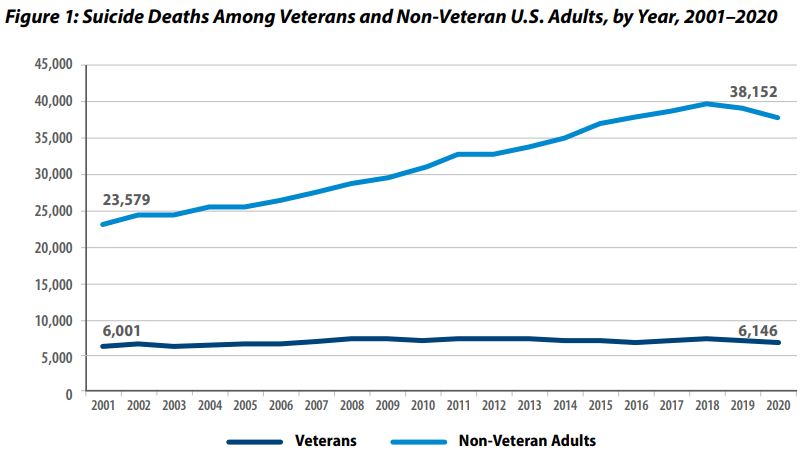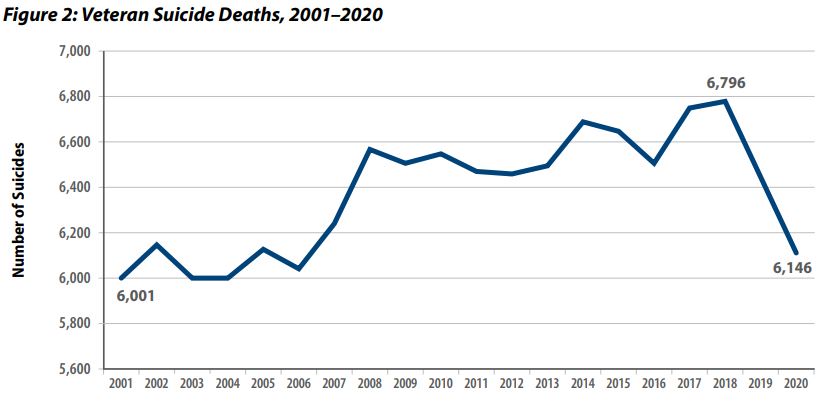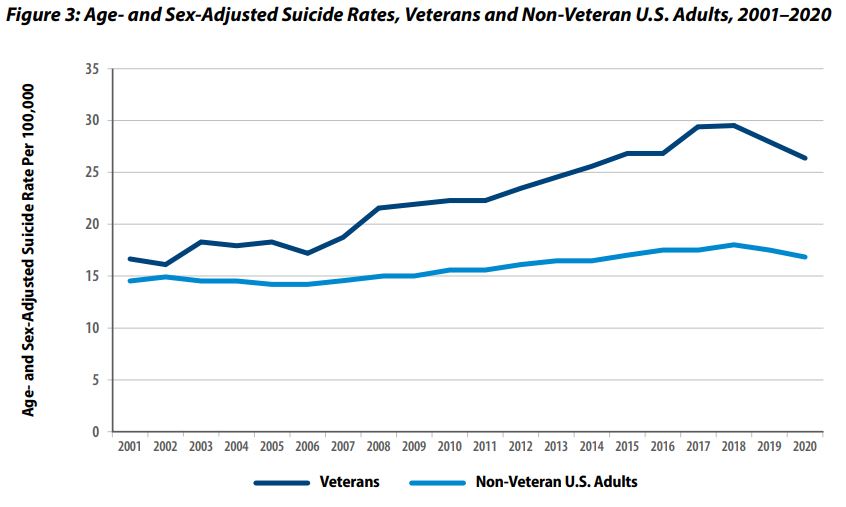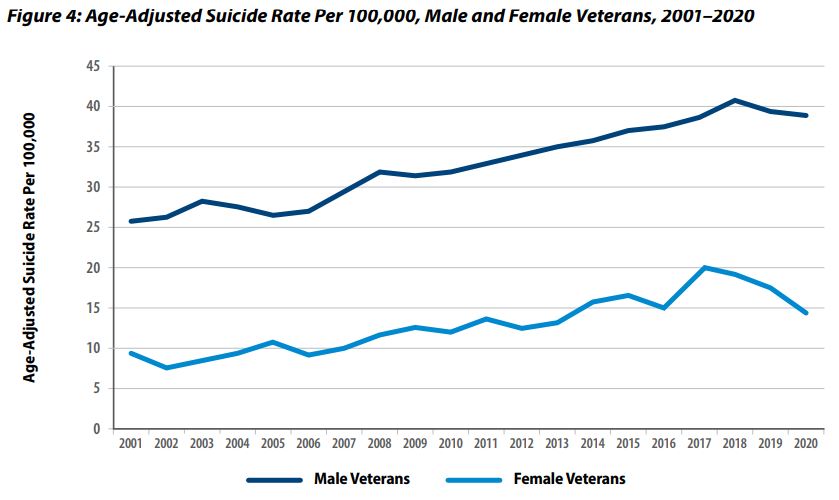Veterans Are Still 57.3% More Likely to Die by Their Own Hand
WASHINGTON, DC — For the second year in a row, veteran suicides decreased in 2020, and fewer veterans died by their own hand in 2020 than in any year since 2006, according to the VA.
That’s according to the 2022 National Veteran Suicide Prevention Annual Report. Key findings included that:
- In 2019 and 2020, veteran suicides decreased in consecutive years by 307 and 343 deaths, which was the biggest decrease in the suicide count and rate since 2001.
- From 2018 to 2020, the age- and sex-adjusted suicide rate among veterans fell by 9.7%
- Among women veterans, the age-adjusted suicide rate fell by 14.1%, compared to 8.4% among non-veteran women. The age-adjusted suicide rate for women veterans in 2020 was the lowest since 2013, and the age-adjusted suicide rate for veteran men was the lowest since 2016.
- From 2019 to 2020, veteran suicide rates fell across all racial groups.
A key result of the survey was that the COVID-19 pandemic did not appear to have an impact on the veteran suicide rate. That was determined by comparing trends in veteran suicide and COVID-19 mortality over the course of 2020 and across veteran demographic and clinical subgroups.
“There is nothing more important to VA than preventing veteran suicide—it’s our top clinical priority,” said VA Secretary Denis McDonough. “This year’s report shows real progress, but there is still so much work to be done. One veteran suicide is one too many, and VA will continue to work with our federal, state, local and private partners to tackle this problem and save veterans’ lives.”
The applause over the reported drop in the veteran suicide rate was blunted, however, by the nearly simultaneous release of a report from the nonprofit America’s Warrior Partnership. According to its Deep Dive study, a reliance on data provided by county coroners has caused VA to overlook thousands of veterans who likely died by suicide, potentially raising the daily rate by 240%.
In 2020, 6,146 veteran suicide deaths occurred, which was 343 fewer than in 2019, according to the VA’s report, which noted that the unadjusted rate of suicide in 2020 among former military servicemembers was 31.7 per 100,000.
From 2001 through 2020, age- and sex-adjusted suicide rates for veterans peaked in 2018 and then fell in 2019 and 2020 by 9.7%, which was much greater than the 5.5% drop among non-veterans, the researchers pointed out.
Veteran Rate Exceeds Non-veterans
Still, each year from 2001 through 2020, age- and sex-adjusted suicide rates of veterans exceeded those of non-veteran U.S. adults. The study noted that the differential in adjusted rates was smallest in 2002, when the veteran rate was 12.1% higher than for non-veterans and largest in 2017, when the veteran rate was 66.2% higher. In 2020, the rate for veterans was 57.3% higher than that of non-veteran adults.
Suicide rates are dropping much more substantially among female veterans compared to males. From 2019 to 2020, among veteran men, the report stated, the age-adjusted suicide rate fell by 0.7%; among veteran women, however, the rate plummeted by 14.1%.
A similar gap was seen among non-veterans—with males having a drop of 2.1% compared to 8.4% for females.
Since 2001, recent veterans who use VHA services were more likely to commit suicide than other veterans. The differential in adjusted rates was smallest in 2018, when the rate for Recent Veteran VHA Users was 9.4% higher, and largest in 2002, when the rate was 80.9% higher. In 2020, the age and sex-adjusted suicide rate of Recent Veteran VHA Users was 43.4% higher than for Other Veterans.
The VA reported that, in 2020, suicide was the 13th leading cause of death among veterans overall, and it was the second-leading cause of death among veterans under age 45.
As a part of the efforts to end veteran suicide, VA also recently announced the grantees for the Staff Sergeant Parker Gordon Fox Suicide Prevention Grant Program, a first-of-its-kind program that provides VA funding for local suicide prevention programs, and the finalists for Mission Daybreak, a suicide prevention grand challenge.
These efforts are key aspects of VA’s 10-year National Strategy for Preventing Veteran Suicide and the White House’s Reducing Military and Veteran Suicide program.
“Suicide is one of the most serious public health issues facing our veterans today, and VA cannot do this work alone,” said VA Under Secretary for Health Shereef Elnahal, MD “With the Staff Sergeant Fox Grants and Mission Daybreak, VA seeks to engage not only organizations traditionally focused on suicide prevention but also to bring in new groups and individuals who may have fresh ideas on how we address this issue.”






